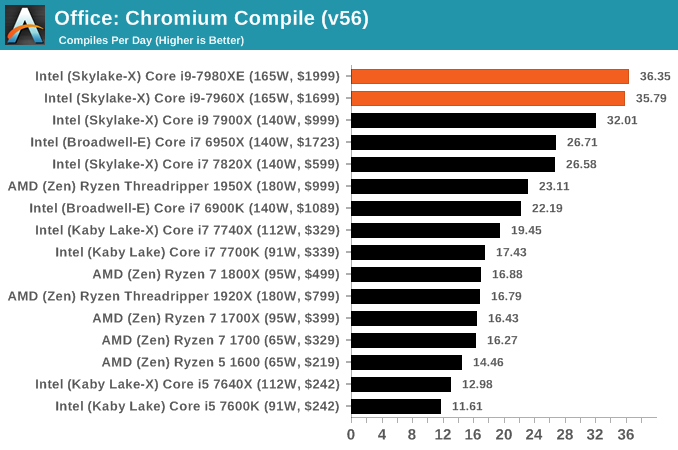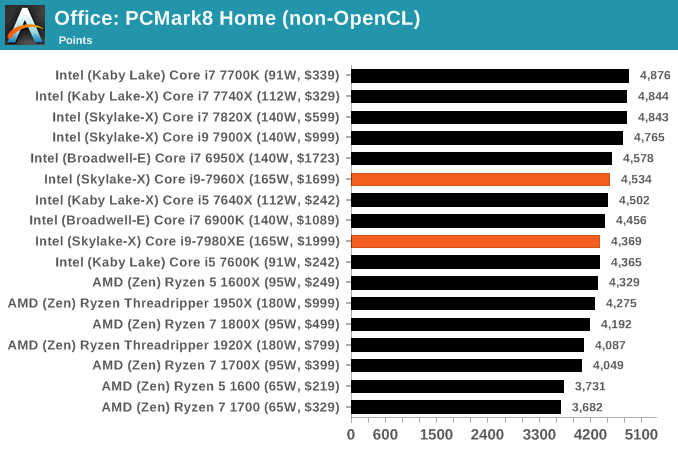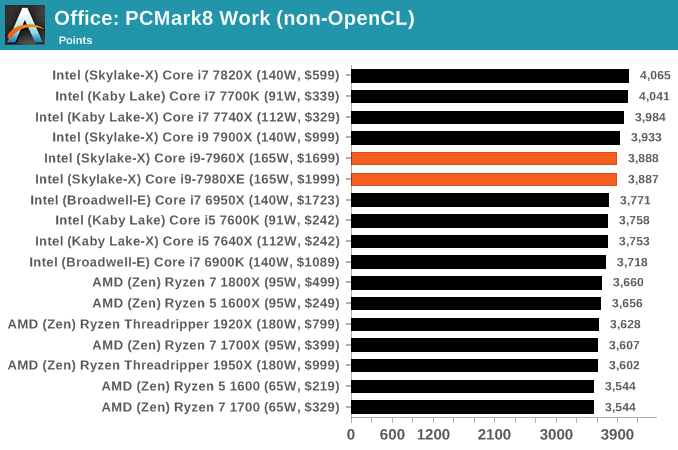The Intel Core i9-7980XE and Core i9-7960X CPU Review Part 1: Workstation
by Ian Cutress on September 25, 2017 3:01 AM ESTBenchmarking Performance: CPU Office Tests
The office programs we use for benchmarking aren't specific programs per-se, but industry standard tests that hold weight with professionals. The goal of these tests is to use an array of software and techniques that a typical office user might encounter, such as video conferencing, document editing, architectural modelling, and so on and so forth.
All of our benchmark results can also be found in our benchmark engine, Bench.
Chromium Compile (v56)
Our new compilation test uses Windows 10 Pro, VS Community 2015.3 with the Win10 SDK to combile a nightly build of Chromium. We've fixed the test for a build in late March 2017, and we run a fresh full compile in our test. Compilation is the typical example given of a variable threaded workload - some of the compile and linking is linear, whereas other parts are multithreaded.

PCMark8: link
Despite originally coming out in 2008/2009, Futuremark has maintained PCMark8 to remain relevant in 2017. On the scale of complicated tasks, PCMark focuses more on the low-to-mid range of professional workloads, making it a good indicator for what people consider 'office' work. We run the benchmark from the commandline in 'conventional' mode, meaning C++ over OpenCL, to remove the graphics card from the equation and focus purely on the CPU. PCMark8 offers Home, Work and Creative workloads, with some software tests shared and others unique to each benchmark set.












152 Comments
View All Comments
mapesdhs - Monday, September 25, 2017 - link
Just curious mmrezaie, why do you say "unofficially"? ECC support is included on specs pages for X399 boards.frowertr - Tuesday, September 26, 2017 - link
Run Unbound on a Pi or other Linux VM and block all thise adverts at the DNS level for all the devices on your LAN. I havent seen a site add anywhere in years from my home.Notmyusualid - Thursday, September 28, 2017 - link
@frowertrInteresting - But that won't work for me - I'm a frequent traveller, and thus on different LANs all the time.
But what works for me, is PeerBlock, then iblocklist.com for the Ad-server & Malicious lists and others, add Microsoft and any other entity I don't want my packets broadcast to (my Antivirus alerts me when I need updates anyway - and thus I temporarily allow http through the firewall for that type of occasion).
realistz - Monday, September 25, 2017 - link
This is why the "core wars" won't be a good thing for consumers. Focus on better single thread perf instead quantity.sonichedgehog360@yahoo.com - Monday, September 25, 2017 - link
On the contrary, single-threaded performance is largely a dead end until we hit quantum computing due to instability inherent to extremely high clock speeds. The core wars is exactly what we need to incentivize developers to improve multi-core scaling and performance: it represents the future of computing.extide - Monday, September 25, 2017 - link
Some things just can't be split up into multiple threads -- it's not a developer skill level or laziness issue, it's just the way it is. Single threaded speed will always be important.PixyMisa - Monday, September 25, 2017 - link
Maybe, but it's still a dead end. It's not going to improve much, ever.HStewart - Monday, September 25, 2017 - link
As a developer for 30 years this is absolutely correct - especially with the user interface logic which includes graphics. Until technology is a truly able to multi-thread the display logic and display hardware - it very important to have single thread performance. I would think this is critically important for games since they deal a lot with screen. Intel has also done something very wise and I believe they realize this important - by allowing some cores to go faster than others. Multi-core is basically hardware assisted multi-threaded applications which is very dependent on application design - most of time threads are used for background tasks. Another critical error is database logic - unless the database core logic is designed to be multithread, you will need single point of entry and in some cases - they database must be on screen thread. Of course with advancement is possible hardware to handle threading and such, it might be possible to over come these limitations. But in NO WAY this is laziness of developer - keep in mind a lot of software has years of development and to completely rewrite the technology is a major and costly effort.lilmoe - Monday, September 25, 2017 - link
There are lots of instances where I'd need summation and other complex algorithm results from millions of records in certain tables. If I'm going the traditional sql route, it would take ages for the computation to return the desired values. I instead divide the load one multiple threads to get a smaller set in which I would perform some cleanup and final arithmetic. Lots of extra work? Yup. More ram per transaction total? Oh yea. Faster? Yes, dramatically faster.WPF was the first attempt by Microsoft to distribute UI load across multiple cores in addition to the gpu, it was so slow in its early days due to lots out inefficiencies and premature multi-core hardware. It's alot better now, but much more work than WinForms as you'd guess. UWP UI is also completely multithreaded.
Android is inching closer to completely have it's UI multithreaded and separate from the main worker thread. We're getting there.
Both you and sonich are correct, but it's also a fact that developers are taking their sweet time to get familiar with and/or use these technologies. Some don't want to that route simply because of technology bias and lock-in.
HStewart - Monday, September 25, 2017 - link
"Both you and sonich are correct, but it's also a fact that developers are taking their sweet time to get familiar with and/or use these technologies. Some don't want to that route simply because of technology bias and lock-in."That is not exactly what I was saying - it completely understandable to use threads to handle calculation - but I am saying that the designed of hardware with a single screen element makes it hard for true multi-threading. Often the critical sections must be lock - especially in a multi-processor system.
The best use of multi-threading and mult-cpu systems is actually in 3D rendering, this is where multiple threads can be use to distribute the load. In been a while since I work with Lightwave 3D and Vue, but in those days I would create a render farm - one of reason, I purchase a Dual Xeon 5160 ten years ago. But now a days processors like these processors here could do the work or 10 or normal machines on my farm ( Xeon was significantly more power then the P4's - pretty much could do the work of 4 or more P4's back then )